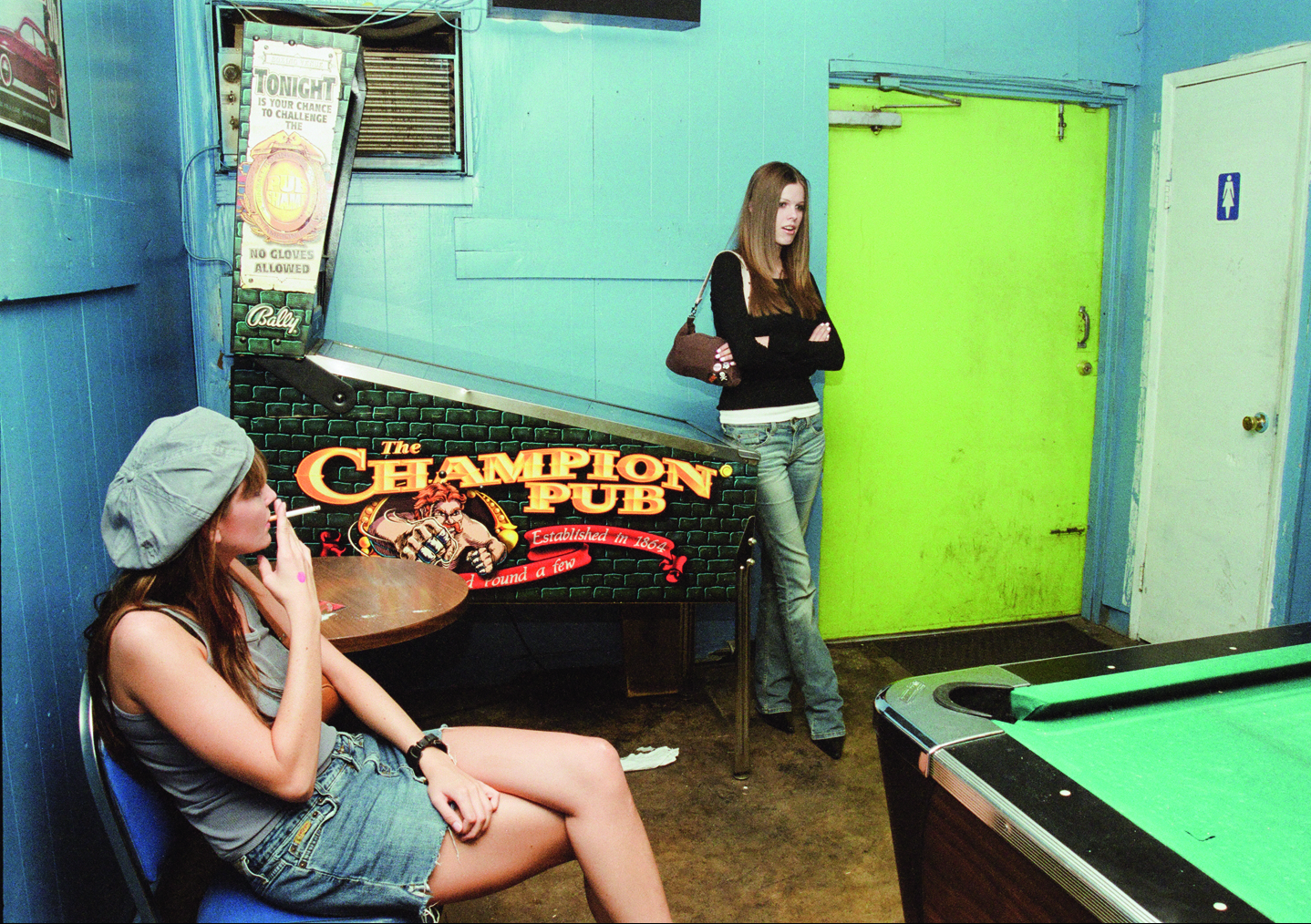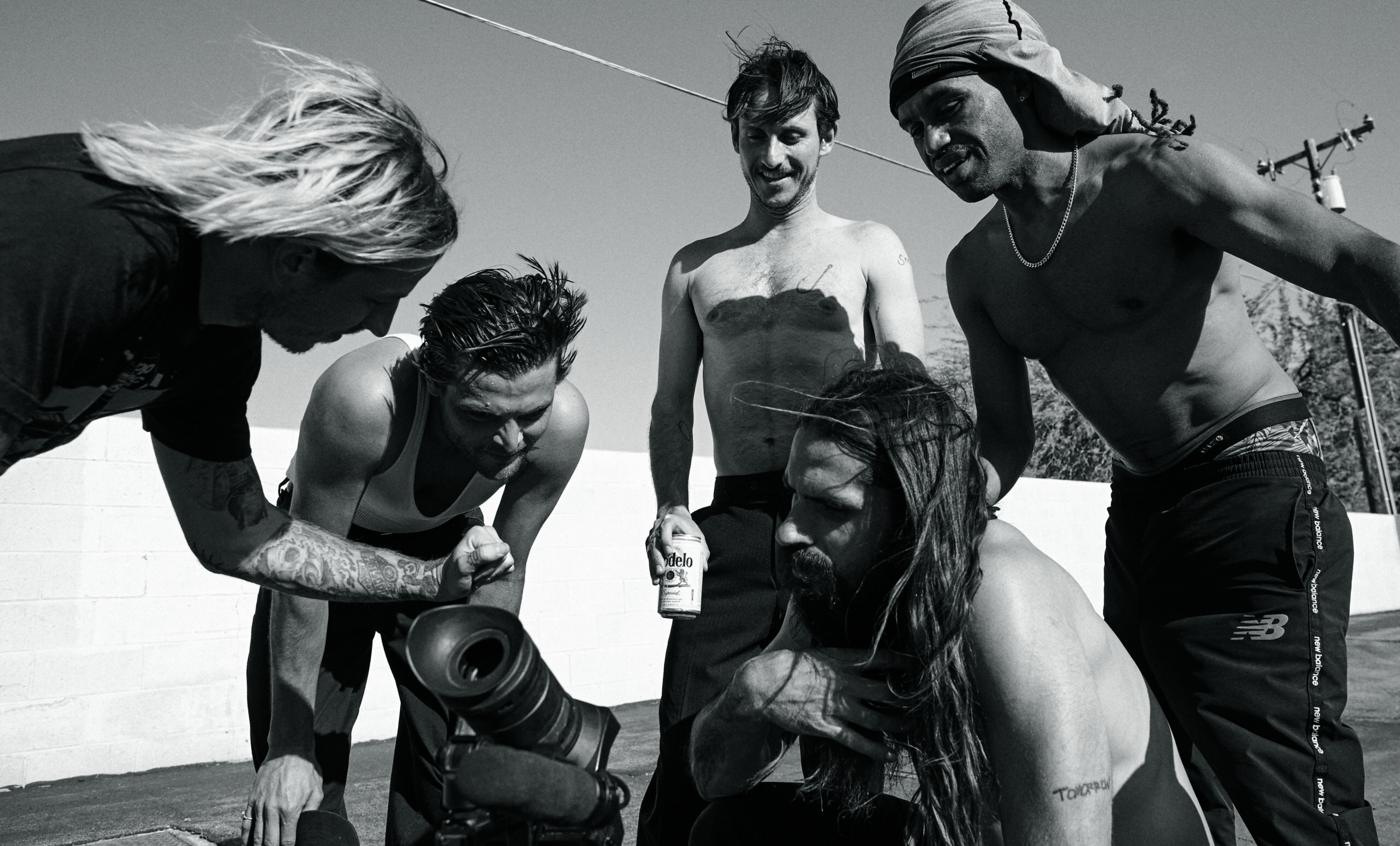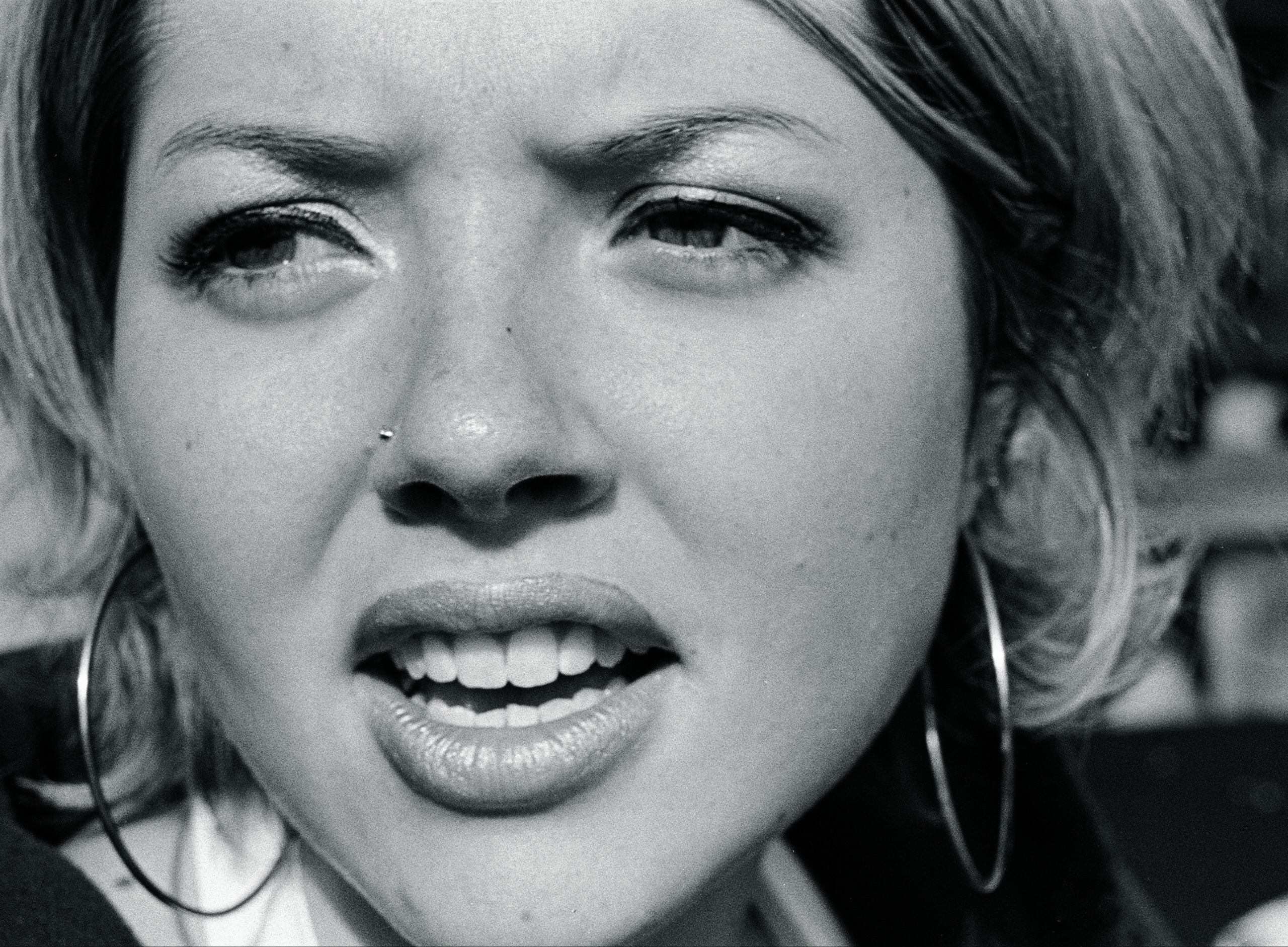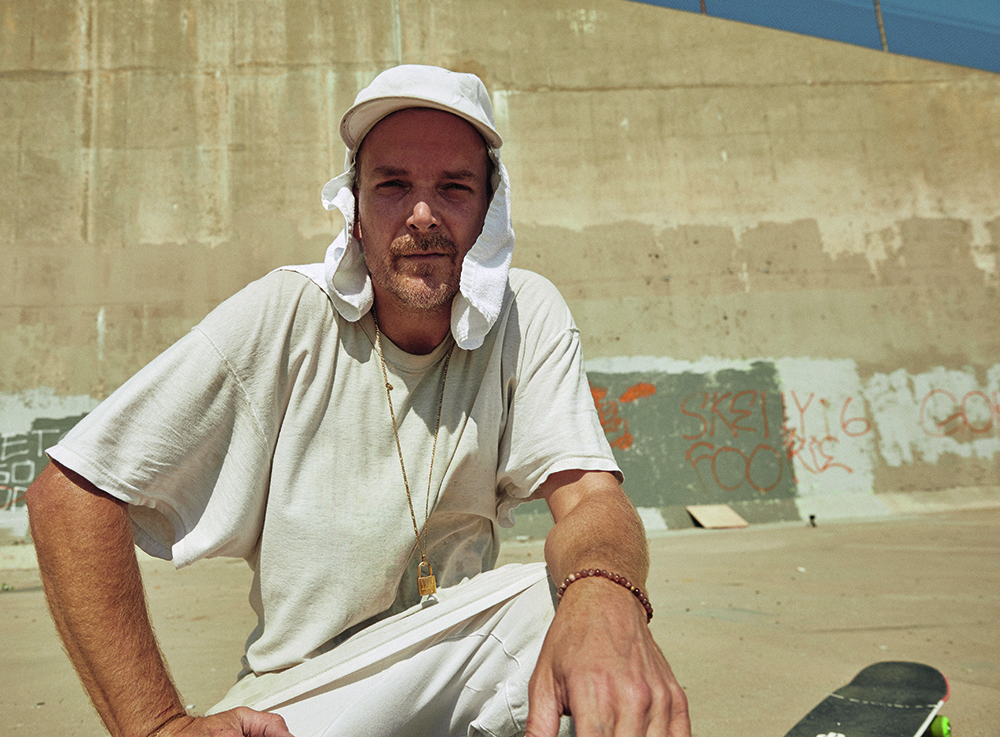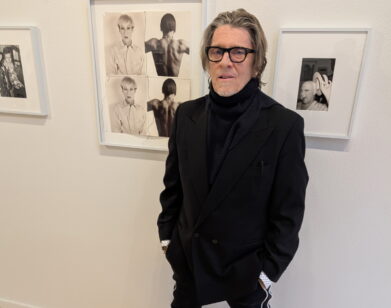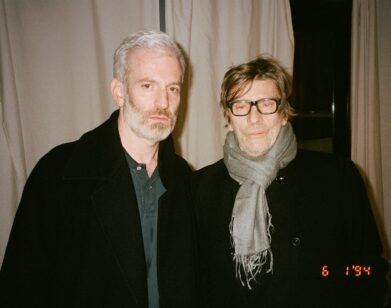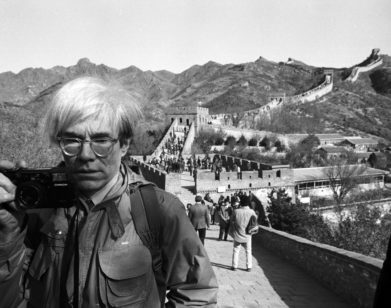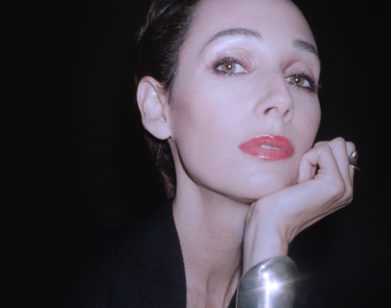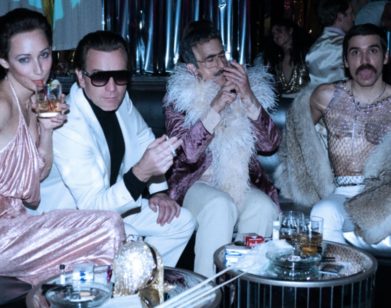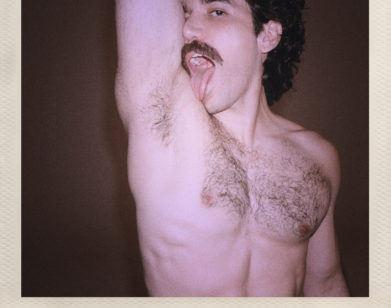CLICK
“You Ghosted Andy Warhol”: Magdalena Wosinska, in Conversation With Christopher Makos
“Moving from communist Poland at the age of eight,” says photographer Magdalena Wosinska, “I slowly found skateboarding as a passport into this weird fucking culture.” Since the 90s, Wosinska has been on the board and the boardwalks, snapping photos of crispy L.A. skaters like Chad Muska and Ed Templeton. Now, Los Angeles’s Fahey Klein Gallery is showing Fulfill the Dream, Wosinska’s vibrant photographs of the scene, addition to a thick book published by Homecoming Gallery. Wosinska’s sumptuous images merge two styles the art world has desperately tried to separate: fine art and street photographs. “You’re like a clean Nan Goldin,” says the photographer and Interview alum Christopher Makos, who knows a thing or two about capturing a micro-culture. Makos left his native California in the 70’s to become a photographer in New York, where he quickly caught the eye of Andy Warhol and Bob Colacello. Last month, from her sunny L.A. studio, Wosinska met with him on Zoom to talk about life-changing encounters, photographing skater boys, and Eastern European resilience. By the end of the call, the two were making plans to pal around New York together this summer.
———
MAGDALENA WOSINSKA: Are you in New York?
CHRISTOPHER MAKOS: Yeah, in New York we’re having 80 degree weather, Magdalena. You’re so pretty. When I look at you, I’m like, “What are you doing photographing them?” They should be photographing you.
WOSINSKA: Oh, you know this as a photographer. I hate being in photos. Do you like being in photos?
MAKOS: I was recently at this big event that I organized in my country studio in Pennsylvania. We hired a photographer. I looked 1,000-years-old. I hated the pictures. Anyway, nough about me.
WOSINSKA: Wait, I do have a question, though. Have you ever had a photographer take a great picture of you?
MAKOS: Wow, what a good question. You want to know the truth? I don’t really hang out with photographers. I hang around with clients.
WOSINSKA: True.
MAKOS: Clients write checks, which is my favorite thing.
WOSINSKA: Same.
MAKOS: Your background is so interesting to me. You moved from Poland as a young teenage girl. One of my biggest collectors, Luba Michailova, she’s from the Ukraine and the thing about you sweet commie girls is you grew up under a different thing. You take nothing for granted, because you come from a system that was so regulated, that you can see the joy of what you do in your photos.
WOSINSKA: Thanks for saying that. I can never over-order at a restaurant, because when people throw food away, I get so bummed. Growing up, you had to have a connection to a butcher to get meat. We got oranges for Christmas. When people throw food away, I’m just like, “This is absurd.” But you end up being very resourceful and frugal. Moving from communist Poland at the age of eight, I slowly found skateboarding as a passport into this weird fucking culture where everything was accessible, but I still couldn’t afford it because we were poor. But coming here, if you can be the first person in your family to have a voice, maybe somebody will give a fuck and listen. My voice is through my eyes and pictures. I’ll never take that for granted.
MAKOS: Do you get back east at all?
WOSINSKA: Yeah, I go to Poland once a year. My dad lives there. After my mom died, I was like, “Dad, go home. Go home to die, but have fun until you do.”
MAKOS: Is your show ongoing right now?
WOSINSKA: Yeah. It’s there until June 1st, so if you happen to be in L.A. in the next month, that’d be awesome. It’s nice to have someone take you seriously and give a fuck, and then if you’re a commercial photographer, to fund your art career, no one takes you seriously in the art world. I’m like, “I don’t have rich parents. How the fuck am I going to pay for this?” Then the commercial world thinks you’re too raw for their commercial world if you’re making art.
MAKOS: Don’t worry. It just takes time. I don’t know if you know my pictures of Warhol in drag, that series called Altered Image.
WOSINSKA: Yeah, of course.
MAKOS: It was a collaborative thing based on Marcel Duchamp. For the longest time, they were always art photos. Then I started doing things with Ferragamo and then they became fashionable. You’ll get there, it just takes time.
WOSINSKA: You have to evolve. And people have to evolve into understanding how you see the world.
MAKOS: Oh, no. Your pictures are so ripe for fashion.
WOSINSKA: Yeah, but the fashion world laughs at me.
MAKOS: Your stuff is so fashionable. So many of these sexy guy pictures that I have, they didn’t mean anything until I did something with Calvin Kliein. All the big brands, they think it’s really sexy to team up with somebody like me. Your moment might be right there or it could be tomorrow. You’re not at the beginning of your career, but you are. You know what I mean? You have nothing to worry about. I looked at all your pictures and your skateboarder book. You’re there. I feel like a judge on American Idol.
WOSINSKA: It feels good to hear you say that though, because I’ve been taking pictures for 26 years and sometimes I’m like, “Is this the beginning? Is this the middle? Is it the transition?” When does everybody else ever decide if it’s cool or not?
MAKOS: Just keep doing you. Hopefully you can find either a sugar mama or sugar daddy to sponsor you. I always say that in order to really make it in Los Angeles, you have to have a gym card and a set of Lululemon outfits.
WOSINSKA: And get into parties at the Chateau, because that’s where your clients are.
MAKOS: Of course. Chateau is sort of really coming back with a vengeance now, isn’t it? A lot of my New York friends always stay there. But when I go to L.A., I’m just trying to find some really cheap Mexican taco shack.
WOSINSKA: Come to Highland Park and I’ll give you a tour.
MAKOS: I’d love to. When did your most recent book come out?
WOSINSKA: It came out April 18th. The opening was amazing, it was like 300-plus people, there was a line around the corner. I was like, “Holy shit!” I would’ve been happy with 50 or 100 people. And then after the show, I played with my punk band at the after party and we had a mosh pit. It was hilarious. And the next day, we had a dinner with collectors and curators and I was like, “Wow, this is such a fascinating life.”I kind of just hang out, live under a rock, take pictures of things that I find interesting. But that weekend I was like, “Oh, I get it.” If you’re friends with people, they’re more likely to put you in the right room with the right people.
MAKOS: You want balance, but it’s fun to hang around with the right people, because that often leads to a different movement in your career. Sometimes being around people in different lanes can open you up to other ideas. I was always open to anything. I remember a collector asked me to do her catalog for a sandpaper company and they’re some of my most interesting artistic pictures, actually. As a project, you should get somebody to sponsor you to come to New York City. The street scenes are sort of over the top here. We’re kind of having a resurgence of the ’70s and ’80s everywhere in America where there are street people, all of that kind of stuff. You can go to the East Village and capture a scene. You can go to the West Village, where I live, and capture a scene, which is all this kind of whiny, entitled white girls. Those girls are unbelievable. Those girls in the ’80s used to be in the Upper East Side. Or you can go to the Upper West Side and see families with babies. Los Angeles is one big, beautiful, sprawling suburb, whereas New York is so condensed. When I look at your pictures, you are ripe for a trip back east. Not on your own dime, though.
WOSINSKA: Oh, I would love that. I need to spend more time there anyway. I used to spend a lot of time there in my twenties and then I was like, “Wow, I’m tired.” I don’t really get that inspired by being in L.A. anymore. I get inspired going back home, connecting to the people in Poland. But in L.A, everyone is so prepared to be cool that it doesn’t feel real. I want it to be raw, and real, and fun. But I have a question for you. Did you have a moment in your career where you met one person that you’re like, “Oh, this changed my career.”
MAKOS: When I was introduced to Andy Warhol, I was shocked because I had thought that he died.
WOSINSKA: [Laughs] Probably ‘cause of the assassination where he didn’t die.
MAKOS: When I came to New York, I was this super cool, blue-eyed, pretty blonde boy from Southern California. Everybody wanted to fuck me.
WOSINSKA: How old were you?
MAKOS: I was like, 19. And I was just cute as a button. I didn’t know anything. But I was smart enough to know how to listen. I listened all the time. I met Warhol and he invited me to go to Max’s Kansas City where Lou Reed and everyone was. I was fresh from Southern California, so a dark club at night didn’t appeal to me.
WOSINSKA: You’re like, “I have to wake up at 6:00 in the morning to catch the surf.” They’re like, “We’re going to do cocaine till 6:00 in the morning…”
MAKOS: Right. I took his number and didn’t follow up like every New Yorker.
WOSINSKA: You ghosted Andy Warhol.
MAKOS: Yeah, I ghosted him. But my first photography show was in New York at 792 West Broadway. It was all my photographs of just my life. This was during Yoko Ono, Nam June Paik, Fluxus Period. Rather than put the pictures on the wall, I took the entire show and put it on the floor and then covered the floor with plexiglass. It was called Step On It. I thought, “This is a good time to meet Warhol.” He couldn’t make it, but Bob Colachello, then editor of Interview Magazine, came. He loved it and said, “Come to the factory.” Bingo! This was my career on my terms, not being just a hanger-on. That moment changed everything.
WOSINSKA: I love that. How old were you?
MAKOS: I must’ve been in my early twenties. That was an amazing time because that was the scene of New York City exporting all of American culture all around the world. Now America exports animosity and politics and all this kind of bullshit. The only sort of nice thing is Taylor Swift and [Travis] Kelce, the football player. That’s the only thing that seems to get any attention other than Donald Trump, which is just unbelievable. I love your studio, by the way.
WOSINSKA: I’m going to give you a tour.
MAKOS: Oh, cool. Please.
WOSINSKA: This is a photo that’s probably the most important thing that I’ve ever done in my career. It’s the cover of the New York Times of me bathing my mom before she passed away.
MAKOS: Oh my god, that’s so beautiful.
WOSINSKA: I was like, “Mom, do you mind if we’re on the cover of The New York Times?” And she’s like, “But what is this New York Times?” And I’m like, “It’s the most famous newspaper in the world.” She’s like, “But why do they want two naked women in bathtub?”
MAKOS: [Laughs]
WOSINSKA: What’s the sketchiest thing that’s ever happened to you on a photo shoot?
MAKOS: Sandra Bernhard. I was doing a photo shoot of her for Interview Magazine and I took a Polaroid of her, which I thought was nice considering what she looks like, and she immediately went to the bathroom crying. I think that she thought she was going to be some beauty, but fashion and makeup can only do so much.
WOSINSKA: You get what you get, right?
MAKOS: I often talk about being a therapist. We help people find out who they are. If we can figure out how to photograph that, then that’s a successful photograph.
WOSINSKA: It’s a trust thing, right? If somebody doesn’t trust you, you’re not going to get a good photo. So many times when I photograph celebrities, they fucking hate being there, it’s an inconvenience. I still think that if you’re being photographed, it’s an honor, so stop being a little bitch and fucking show up and be kind. But I figured out a little system. I show up alone, I never bring an assistant, I don’t bring a DigiTech, I shoot on a film camera, I show up with a tiny camera that nobody takes seriously, so they’re not intimidated by it. They might want the bells and whistles but I’m like, “I’m not going to give it to you because we’re fucking equal. Let’s make a good picture. That’s the only thing I care about right now. To connect to your soul.”
MAKOS: Yeah, exactly. I give you such kudos for breaking through. Number one, because you’re a woman. And number two, you have to be so strong to do that out there. Everything’s harder if you’re a woman. That’s changing, fortunately. And of course, your narrative is so cool. Polish, former commie girl. I love that story. All the people that came from the former Soviet Union were really resourceful.
WOSINSKA: Totally. And not only being a woman in this world, but I shoot so many different things and everybody wants to pigeonhole me. Why can’t I be good at all of it? People ask me, “Do you feel more Polish or American?” I’m like, “I have a Polish soul and I live an American lifestyle.” My heart and resilience and sense of self comes from just a completely different culture. I want to ask you, who made the biggest impact on your life in the beginning of your photo career?
MAKOS: People like Tennessee Williams. I photographed Tennessee Williams early on in front of Harry Winston Jewelers. Another person was Elizabeth Taylor, because I knew Malcolm Forbes quite well and that’s when Malcolm Forbes and her were sort of pretending to date each other. Most of my adult life, I have been lucky enough to be around all kinds of interesting people that have given me so much. I always say, “If I get hit on my bike tomorrow, don’t worry. I’ve lived the lives of 10 of you.”
WOSINSKA: You deserve it all. My goal is to show in museums. Hopefully people will take me seriously so I can do that in the next two to five years.
MAKOS: Don’t worry, that’s going to happen in a minute. Trust me. You’re like a clean Nan Goldin. You know what I mean?
WOSINSKA: Thank god.
MAKOS: You know Nan Goldin’s work. It’s all dark and drug addicts and dicks and vaginas…
WOSINSKA: Mine’s like, dicks and vaginas but in the sunshine on a cliff.
MAKOS: Which is perfect, because no one’s doing that. What do you want to do next?
WOSINSKA: I hope this book gets connected to a lot of people in the world.
MAKOS: Who’s publishing it?
WOSINSKA: Homecoming Gallery. They’re from Amsterdam. It’s a female-run publisher. It was really cool because I pitched this book to a lot of publishers and they all said-
MAKOS: No.
WOSINSKA: “Unfortunately, we have a lot of other books coming out.” All male photographers, of course. And I was like, “Has a woman ever put out a book about skateboarding?” And they’re like, “No.” And I’m like, “Okay, cool. Get back to me in a couple years when you realize you should have done this.”
MAKOS: Well, you understand that no book company is going to promote your book in the way that you can, right?
WOSINSKA: That’s why I wheat pasted shit all over L.A. with a bunch of taggers.
MAKOS: Oh, cool. I could get you a talk and a gig at the Strand Bookstore in New York City, which is the most important bookstore in America.
WOSINSKA: I would be so honored to do that. You’re fascinating. We’re definitely hanging out when I come to New York.
MAKOS: Oh, for sure. And I know the people at The Strand. You’ll get my whole New York crowd, which is easy to do.
WOSINSKA: We’re going to become best friends by accident by the end of this.




